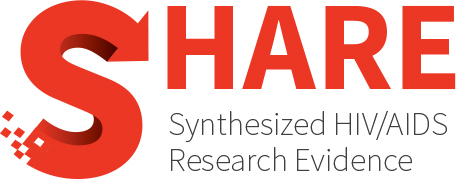Category Archives: Prevention, Engagement and Care Cascade
Effectiveness of eHealth interventions for HIV prevention, testing and management: An umbrella review
BACKGROUND: Human immunodeficiency virus (HIV) infection has become a major contributor to the global burden of disease. Globally, the number of cases of HIV continues to increase. Electronic health (eHealth)...
Identifying best practices for increasing HIV pre-exposure prophylaxis (PrEP) use and persistence in the United States: A systematic review
A qualitative systematic review was conducted to evaluate pre-exposure prophylaxis (PrEP) interventions, describe characteristics of best practices for increasing PrEP use and persistence, and explore research gaps based on current...
Health-related quality of life in people with advanced HIV disease, from 1996 to 2021: Systematic review and meta-analysis
The purpose of the study was to assess the effects of advanced HIV disease (AHD) on health-related quality of life (HRQoL) in PLHIV, the changes in HRQoL outcomes over the...
Clinical outcomes after acute coronary syndromes or revascularization among people living with HIV: A systematic review and meta-analysis
Importance Clinical outcomes after acute coronary syndromes (ACS) or percutaneous coronary interventions (PCIs) in people living with HIV have not been characterized in sufficient detail, and extant data have not...
The impact of armed conflicts on HIV treatment outcomes in Sub-Saharan Africa: A systematic review and meta-analysis
Background Despite the fact that Sub-Saharan Africa bears a disproportionate burden of armed conflicts and HIV infection, there has been inadequate synthesis of the impact of armed conflict on HIV...
Analysis and mapping of global research publications on point-of-care testing for infectious diseases
RATIONALE: This study presents the first comprehensive analysis and mapping of scientific research on point-of-care testing (POCT) in infectious diseases, filling a gap in understanding the evolving landscape of this...
Evaluating the use of antiviral drugs in HIV patients with cardiovascular diseases and how to reduce the incidence of cardiac events in these patients
Globally, the incidence of newly diagnosed human immunodeficiency virus (HIV) infections is concerning. Despite enhancing the quality of life for this patient population, antiretroviral therapy (ART) is linked to an...
The impact of the M184V resistance mutation on treatment outcomes in patients with HIV infection: A systematic review and meta-analysis
HIV is a global deliberating infectious disease. Of note, more than 36 million people living with HIV (PLHIV) with approximately newly diagnosed 1.5 million cases annually. M184V is a single...
Prevalence and factors associated with viral non-suppression in people living with HIV receiving antiretroviral therapy in sub-Saharan Africa: A systematic review and meta-analysis
Despite advances in HIV treatment, the burden of viral non-suppression (VNS) remains a treatment success concern, particularly in Sub-Saharan African (SSA) countries. We determined the prevalence and factors associated with...
Mortality and its predictors among human immunodeficiency virus-infected children younger than 15 years receiving antiretroviral therapy in Ethiopia: A systematic review and meta-analysis
BACKGROUND: Despite antiretroviral treatment (ART), the human immunodeficiency virus (HIV) continues to pose a considerable health burden in resource-poor countries. This systematic review and meta-analysis aimed to determine the pooled...
Incidence rate of mortality and its predictors among tuberculosis and human immunodeficiency virus coinfected patients on antiretroviral therapy in Ethiopia: Systematic review and meta-analysis
Background Tuberculosis (TB) is the leading cause of death among HIV-infected adults and children globally. Therefore, this study was aimed at determining the pooled mortality rate and its predictors among...
Fast-track interventions for HIV and AIDS epidemic control among key populations: A rapid review
BACKGROUND: Targeted interventions for key populations remain critical for realisation of epidemic control for human immunodeficiency virus (HIV) infection because of the causal relationship between HIV infection in the general...
